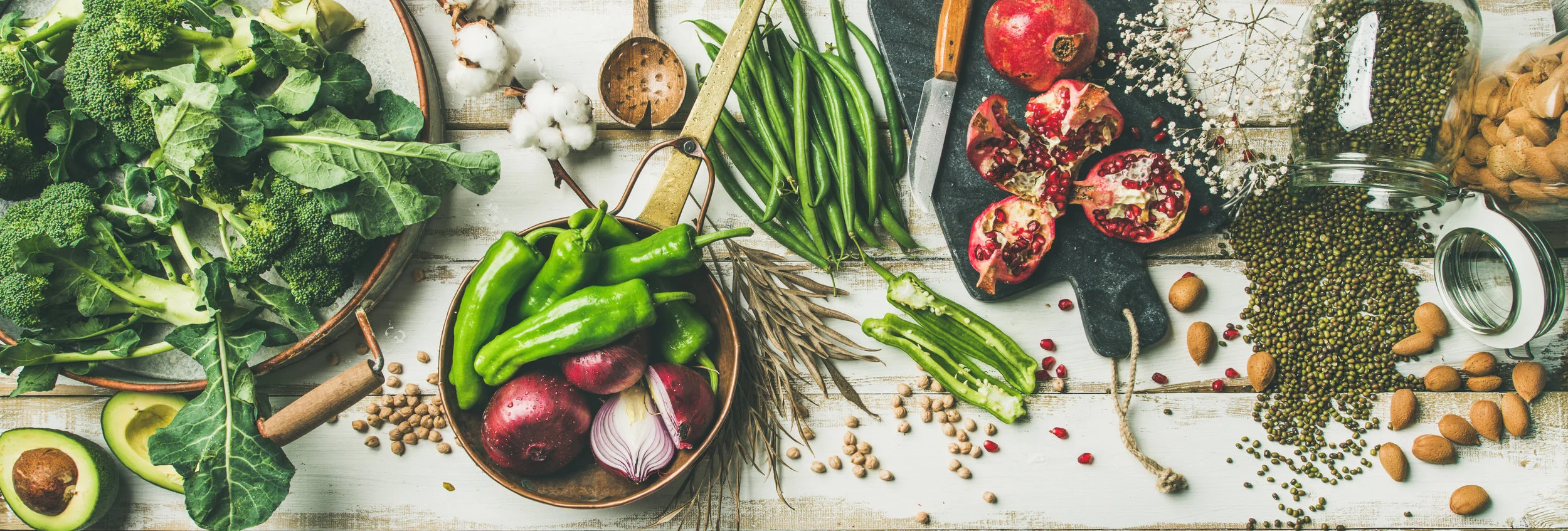The Basics, Yin & Yang Foods & Food Preparation Methods
Raw
Raw foods are typically cooling (yin). This means that eating raw vegetables in a cold season/climate, or if ones internal body feels cold, you may find comfort in heating your vegetables and avoiding raw until your climate, season or body changes.
A couple exceptions to the rule here is the bell pepper and radishes. Even though these vegetables are warmer compared to the others, in Traditional Chinese Medicine it is common to avoid raw. It is frequently considered that adding “yang energy” aids with digestion.
Roasting
Roasting foods adds yang energy to food regardless of what their temperature property are prior to roasting . For example if you have a cooling food like broccoli, roasting it will take away its “cooling property”. This is a good option for colder climates or winter seasons.
The ingredients in the dish above are either Hot, warming, neutral with sweetness. Roasting this dish makes it even more warming/hot. The sweet properties combined with oil/fat you choose to cook with can also create “damp heat”, which will be discussed in later posts.
When would you not want to eat a dish like this? Fevers, feeling of internal heat or hot sensation, feeling of heaviness, sluggish, decreased cognition, during a hot humid day in the summer, Inflammation in the body especially systemic, excessive appetite, large thirsty sensation for cooling beverages. These are a few examples.
Braising
Braising food adds only a slight amount of yang energy to the food. It is commonly used in combination with “low and slow” cooking times (stews & soups). Braising utilizes reduced heat or yang energy making foods less likely to be damaged by destroying important enzymes. This method is common for many different foods (Meat, Vegetables, Fish)
Braising is great way to prepare a meal and can be used through all seasons while maintaining attention to food properties and individual TCM patterns. Remember it is still slightly warming.
Cooking with Alcohol
Adding alcohol while cooking adds additional yang energy. All alcoholic variants will add yang energy, but there can be a lot of diversity between the different alcohols, making cooking with the right alcohol slightly more complex. For example: excluding the fact that all alcohols will be warming (yang), we see in Traditional Chinese Medicine (TCM) other properties that can be present: hot, damp, sweet, bitter, dry etc. Consider whisky (hot & dry) vs. cider (dry or sweet/damp), or cocktail (sweet & damp) vs. beer (damp). Different alcohols influence our bodies in different ways and can be seen through emotional expression or felt by the participants in the body with experiences like angry, irritability, heaviness, energetic “wild” etc.
In TCM we consider all alcohol to increase “qi and blood circulation” This can be understood by alcohols well-known blood thinning (anticoagulant) ability.
Alcohol is also given the property to “up lift or raise up qi”. We can sometimes visually see this when an individual has had too much to drink and their face becomes flushed. Participants often feel like their emotions have been up lifted after a bad day. This is a tool unfortunately utilized far too often in our society, as a little of this every day for years develops in to different pathologies, seen in both eastern and western medicine.
In general consider cooking with alcohol to be more of an “uncommon, special process” to increase yang energy, the flavor of meals, stimulate qi or blood circulation, as well as relieving emotional blockages or tension (short term).
Adding Salt
Adding Salt to foods or pickling foods in a brine is considered cooling and yin. However do not be fooled, just because something is pickled in brine it does not always mean that it will be cooling. For example, the spiciness of Korean kimchi. Although the pickling process cools or decreases hot foods, it will not typically extinguish or neutralize them.
A great time to add pickles to your diet can be during pregnancy. It is quite common for women to crave pickles during pregnancy and in Traditional Chinese Medicine we would associate this with the mother requiring additional yin energy to nourish herself and baby.
It is also important to note that too much yin is not necessarily a good thing.
Examples:
1) It is common to see excessive yin as stored fat. Poor diet choices and lack of exercise (yang) eventually leads to obesity and a multitude of other health problems.
2) Excessive yin (due to excessive salt in the diet) can also manifest through increased blood pressure.
Balance combined with body-mind awareness is the key.
Steaming
Steaming food is generally considered to be a neutral form of cooking as it does not typically change the yin (cooling) or yang (warming) characteristics of the food. However the structure of a food, yin (solid) and yang (soft) can change and will be affected by the length of time food is steamed.
Steaming is a preferred cooking method especially when combined with utilizing shorter cook times (time dependence is variable with the type of food being cooked). Typically with vegetables a general rule is to retain a rigid (yin) or “crunch” textural quality. The longer a food is steamed the more yin is pushed out it of it, making its texture more soft or soggy (yang) which is considered to be less nurturing (yin). Example broccoli steamed for 5 mins will be considerably different (both in texture and nutrient value) than broccoli steamed for 20 mins
Boiling/Simmering
Boiling/simmering food adds yang energy. The amount of yang energy varies with how long the food is boiled/simmered. Cold seasons and climates are a great time of year to boil/simmer meals
Examples of meals most commonly boiled/simmered are soups and stews. Traditionally these meals are brought to a quick boil and then reduced to a simmer over long periods of time (12hrs or longer). This is similar to the way several Chinese herbal decoctions are prepared. Soups and stews are an excellent tool to aid in recovery support for things like prolonged illnesses, post partum, and fatigue.
Meat vs. Vegetable general rules.
Meat can be cooked for longer periods of time, breaking down into the broth
Vegetables are added in the later stage to avoid nutrient losses or are cooked for shorter lengths of time if only making a vegetable base soup.
Smoking
Smoking food adds yang energy to food. Smoking can add brilliant flavor and is commonly used with meats and cheese.
Smoking food is one of the oldest forms of preserving food (typically meats) and was a method commonly used before refrigeration.
Smoked foods can be unsafe to eat, especially if consumed frequently. This is typically because smoked foods are combined with high amounts of sodium and can have high levels of polycyclic aromatic hydrocarbons (PAH’s), which are carcinogenic.
To avoid PAH’s and high amounts of sodium, know where and how your food was smoked! Low temperature over longer/slower smoking times utilizes safer and tastier results.


